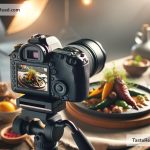Unlocking the Secrets to Stunning Food Photography: Essential Lighting Techniques
Let’s face it, we all love scrolling through our social media and pausing at those mouth-watering food photos. There’s something about them that makes us immediately hungry or inspires us to whip up something delicious. Ever wondered what makes those photos look so appealing? Well, one of the main ingredients behind drool-worthy food photography is effective lighting.
Understanding the basics of lighting can elevate your food photography from good to great. Whether you’re a budding food blogger, a culinary enthusiast, or just someone aiming to level up their Instagram game, mastering these essential lighting techniques will help you capture food in its most tantalizing form. So, let’s dive into some simple yet effective tips to light up your culinary captures!
1. Natural Light is Your Best Friend
The first rule of thumb for exquisite food photography is to harness the power of natural light. The soft, diffused light from a nearby window can work wonders and is often preferred over artificial lighting. Position your food setup close to a window, using indirect light for a gentle and natural look. Morning and late afternoon hours are golden for photographers due to the warm and soft quality of light during these times. However, remember to avoid direct sunlight as it can cast harsh shadows and highlights, making your food look unappealing.
2. Use Reflectors and Diffusers
Even when using natural light, you might encounter challenges like shadows or too much contrast. This is where reflectors and diffusers come into play. They can be professionally bought or simply DIYed using white cardboard or sheer white fabric. Reflectors bounce light back onto the darker side of your subject, filling in shadows for a balanced look. Diffusers, on the other hand, spread the light more evenly, softening any harshness. By manipulating light with these tools, you can achieve a more evenly lit and pleasing photograph.
3. Experiment with Artificial Light
While natural light is unbeatable for its beauty, it’s not always available, especially for nighttime shoots or in regions with long winters. This is where artificial lighting steps in. LED panels and ring lights are popular choices for food photography as they offer adjustable intensities and temperatures. When using artificial light, positioning is key. Place your light source to the side or behind the subject for an appealing look, as direct frontal lighting can make food appear flat and dull.
4. Play with Shadows for Drama
Contrary to popular belief, shadows aren’t your enemy. When used correctly, they can add depth, dimension, and drama to your food photographs. Side lighting, achieved by placing your light source at a 90-degree angle to the food, creates beautiful shadows that give a sense of volume and texture to the dish. Experiment with the distance and angle of your light source to control the intensity of the shadows for that perfect dramatic effect.
5. Mind the Background and Colors
The right lighting not only highlights your subject but also sets the mood and atmosphere of the photograph. Using colored gels or colored lights can inject emotion or seasonal vibes into your photos. However, caution is advised as overdoing it can distract from the food itself. Additionally, consider the color and texture of your background and its interaction with light, as it contributes significantly to the overall composition and feel of your photo.
Stay Patient and Keep Experimenting
Mastering food photography and its various lighting techniques is a journey of trial and error. Be patient with yourself, and don’t be afraid to experiment with different setups, angles, and lighting conditions. Each type of food has its unique charm that can be accentuated with the right lighting. Whether it’s the steam rising from a hot bowl of soup or the glossy shine on a chocolate cake, proper lighting can turn simple dishes into irresistible temptations.
In conclusion, lighting in food photography is much more than just making your subject visible. It’s about creating a mood, telling a story, and evoking an emotion. By following these essential lighting techniques, you’re well on your way to capturing food in its most captivating and appetizing form. Remember, practice makes perfect, so grab your camera and start playing with light. Happy shooting!


